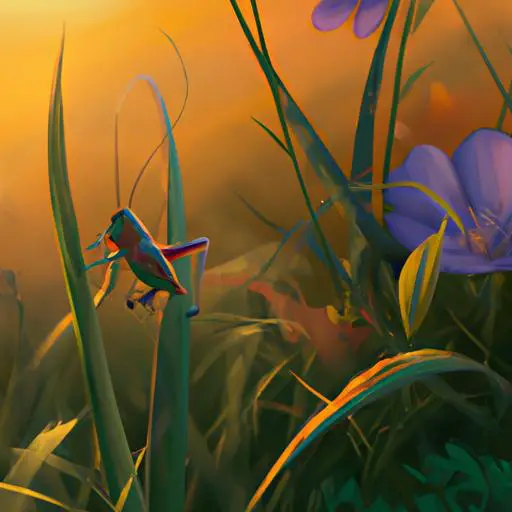Have you ever wanted to have a pet but don’t have the time or space for a furry companion? Are you interested in learning more about an unusual, yet surprisingly rewarding, pet? If so, keeping crickets as pets could be the perfect option for you! Crickets make great pets and can provide hours of entertainment for people of all ages.
This comprehensive guide will provide you with all the information you need to know about keeping crickets as pets, from the benefits to the housing requirements, what to feed them, cleaning and maintaining the enclosure, handling and interacting with your pet crickets, common health issues, and even breeding them.
Read on to learn more!
Table of Contents
Short Answer
Keeping crickets as pets is relatively easy and inexpensive.
You’ll need to provide them with a tank with good ventilation, as well as a substrate like soil or newspaper on the bottom of the tank.
Make sure the tank also has a secure lid to prevent the crickets from escaping.
You’ll also need to feed the crickets a variety of food, such as vegetables, fruits, and cricket food.
Finally, keep the tank at room temperature and provide the crickets with plenty of hiding spots.
Benefits of Keeping Crickets as Pets
Keeping crickets as pets has many benefits, including their low-maintenance nature, their ability to bring joy to their owners, and their relatively short lifespan.
For those who are new to pet ownership, crickets can make an ideal first pet.
They are relatively easy to care for and require minimal space.
They also make wonderful companions, providing hours of entertainment with their curious behaviour and unique chirping.
In addition, since crickets have a relatively short lifespan of just a few months, they are an ideal choice for those who are unable or unwilling to commit to the long-term care of a pet.
Housing Requirements for Crickets

Crickets make wonderful, low-maintenance pets suitable for both beginner and experienced pet owners alike.
While keeping crickets as pets is relatively easy, it does require the right setup and maintenance to ensure their health and happiness.
Proper housing is essential for keeping your crickets happy and healthy.
The size of the enclosure you choose will depend on the number of crickets you plan to keep.
Generally, you will need at least 10 gallons of space per cricket.
The enclosure should also provide plenty of space for them to move around and explore.
Additionally, the enclosure should include objects for the crickets to hide in such as stones, wood, or other materials.
The enclosure should also provide a food source and a water source.
You can provide commercial food pellets as a primary food source, and you can supplement this with fresh fruits and vegetables.
For the water source, you can use a shallow dish that is filled with water and a few drops of dish soap to keep it from evaporating quickly.
The enclosure should also be kept clean to prevent disease.
This means cleaning out uneaten food, changing the water source regularly, and removing any objects that may have become contaminated.
Additionally, the enclosure should be kept at a temperature between 65-85 degrees Fahrenheit and should have a humidity level of about 45-55%.
With the right setup, crickets can make wonderful, long-term pets.
Providing your crickets with a clean, spacious enclosure and a balanced diet will ensure their health and happiness.
By following these simple guidelines, you can create a safe and comfortable environment for your crickets to live in.
What to Feed Cricket Pets
Keeping crickets as pets is relatively easy, but one of the most important aspects is providing them with a balanced diet.
Crickets are omnivores, meaning they need both plant and animal-based foods to stay healthy.
Commercial cricket food is available at most pet stores, and consists of a mixture of dried grains, vegetables, and other nutritious ingredients.
This should form the basis of their diet, although they will also benefit from the occasional treat of fresh fruits and vegetables.
Fruits such as apples, bananas, and grapes can be offered in small amounts, while vegetables such as carrots, celery, and broccoli are also great options.
Crickets should also be given a source of calcium, such as cuttlebone, to ensure healthy growth and development.
Its important to keep food and water dishes clean to prevent the spread of disease.
Cleaning and Maintaining the Enclosure

Keeping your pet crickets enclosure clean is one of the most important aspects of owning them.
A clean environment will help keep your crickets healthy and happy, and also prevent the spread of diseases.
Fortunately, it doesnt take much time or effort to keep a cricket enclosure clean.
The first step of cleaning a cricket enclosure is to remove any old food or waste that has accumulated.
Once all the old food and waste is removed, you can then clean the enclosure with a mild soap and warm water.
Be sure to rinse the enclosure thoroughly so that no soap residue remains.
Once the enclosure is clean, youll want to add fresh substrate to the bottom of the enclosure.
Substrate is the material that your crickets will live in, such as sand, soil, or peat moss.
Adding a layer of substrate will provide your crickets with a comfortable environment while also helping to absorb any moisture or waste.
Its also important to keep the humidity levels in the enclosure at the proper levels.
Too much humidity can cause mold and mildew to form, while too little can cause the crickets to become dehydrated.
An ideal humidity level for cricket enclosures is between 60-80%.
You can measure and adjust the humidity levels in the enclosure with a simple hygrometer.
Finally, youll want to make sure that the enclosure is well ventilated.
Good ventilation will help keep the crickets healthy and prevent the buildup of ammonia and other toxins.
Be sure to check the ventilation regularly and make sure that the air is circulating properly throughout the enclosure.
By following these simple steps, you can help ensure that your pet crickets are living in a safe and clean environment.
With a little bit of effort, you can keep your cricket enclosure clean and healthy for years to come.
Handling and Interacting with Pet Crickets
Handling and interacting with pet crickets is an important part of keeping them as pets.
While crickets can be skittish and may jump when startled, they can also be gentle and can be handled carefully with some basic precautions.
When handling crickets, it is important to use slow and gentle movements to avoid startling them.
Crickets can be held in the palm of ones hand and can be petted with a finger.
Many people find that crickets enjoy being around people and may even climb onto their hands or arms.
It is important to keep in mind that crickets can bite if mishandled, so it is important to be gentle and to wash ones hands after handling them.
Crickets can also be trained to climb onto a finger or hand and can even be trained to do tricks.
This is an enjoyable activity for both the cricket and the handler.
To train a cricket, it is important to use positive reinforcement and to reward the cricket with treats when it accomplishes a task.
This may include providing the cricket with a fresh fruit or vegetable as a reward.
It is important to use patience and to be consistent when training a cricket.
With enough practice, crickets can learn to jump through hoops or even perform basic commands.
Common Health Issues in Cricket Pets

Crickets make wonderful, low-maintenance pets and can be suitable for both beginner and experienced pet owners alike.
Unfortunately, like all pets, they can experience health issues that arise without proper care and maintenance.
To ensure the health and happiness of your cricket, its important to be aware of the most common health issues they can experience.
The most common health issue in pet crickets is dehydration.
Because crickets require moisture in their environment, its important to provide a humid environment by misting the enclosure with water.
Additionally, its important to provide a water source such as a damp sponge or cotton ball.
Another common health issue in pet crickets is malnutrition.
Because crickets are omnivores, they need a balanced diet of both commercial food and fresh fruits and vegetables.
Without a balanced diet, your cricket can suffer from malnutrition, which can lead to poor growth, lethargy, and even death.
Finally, pet crickets can experience disease if their environment is not kept clean.
Its important to regularly clean the enclosure, including the substrate, food and water dishes, and any other materials that the cricket may come in contact with.
This will help to prevent the spread of disease and keep your pet healthy.
By understanding these common health issues and taking steps to prevent them, you can ensure that your pet cricket remains healthy and happy for years to come.
Breeding Pet Crickets
Breeding pet crickets is a great way to create a fun and unique pet-keeping experience.
Breeding crickets can be a rewarding experience for both beginner and experienced pet owners alike.
With the right setup and maintenance, crickets can be easily bred to create a healthy and happy colony.
When setting up a cricket breeding enclosure, it is important to provide enough space for the crickets to move around.
The enclosure should also include a variety of food and water sources, as well as hiding places for the crickets to take shelter.
The enclosure should also be kept clean to prevent the spread of disease.
When breeding pet crickets, it is important to provide a balanced diet.
Commercial cricket food is available for purchase and can provide a good base to their diet.
Fresh fruits and vegetables should also be provided, as well as calcium-rich materials such as eggshells.
These can be used to supplement the crickets diet and keep them healthy.
In order to successfully breed pet crickets, it is important to pay close attention to the environment.
The temperature and humidity of the enclosure should be monitored to ensure the crickets health and happiness.
It is also important to monitor the crickets for signs of disease and to take steps to prevent the spread of any illnesses.
With the right setup and maintenance, breeding pet crickets can be an enjoyable and rewarding experience.
With the right care, crickets can make wonderful, long-term pets.
Final Thoughts
Keeping crickets as pets offers a unique experience that is perfect for both beginner and experienced pet owners alike.
With the right housing, diet, and maintenance, crickets can make wonderful, long-term pets.
If you’re looking to add a new pet to your home, crickets are an excellent choice.
Be sure to research the housing requirements, diet, and other important factors before bringing a cricket home.
With the right care and handling, your cricket pet can bring you years of enjoyment.

